Complete Health Indicator Report of Community Design: Commute Time
Definition
Commute time using different modes of transportationNumerator
Number of workers 16 years and older driving 20+ minutes to work [[br]] [[br]] Number and of workers 16 years and older taking public transit 45+ minutes to work [[br]] [[br]] Number of workers 16 Years and older walking 10+ minutes to workDenominator
Workers age 16 years and older in a given geographic areaData Interpretation Issues
This dataset only captures commute time to work and does not capture the distance of the trip. [[br]] [[br]] Personal preference and economics also influences commute choices, not just community design. [[br]] [[br]] The American Community Survey (ACS) is a nationwide, continuous survey designed to provide communities with reliable and timely demographic, housing, social, and economic data every year. However, because ACS data are based on a sample, they are subject to sampling variability and include a range of uncertainty. [[br]][[br]] While the ACS provides population, demographic and housing unit estimates, the Census Bureau's Population Estimates Program produces and disseminates the official estimates of the population for the nation, states, counties, cities, and towns.Why Is This Important?
Americans spend considerable time traveling to and from work. In 2013, 86% of American workers commuted by car, while the remainder used other forms of transportation such as public and active (e.g., bicycling and walking) transportation.^1^ [[br]] [[br]] Time spent commuting is associated with several health outcomes, dependending on the travel mode. Longer commute times are generally linked to decreased mental health. Commuting by car for longer periods of time is associated with reduced physical activity and increased levels of obesity. Walking, bicycling, and taking public transportation to work are shown to increase physical activity and weight loss. Tracking how Utahns travel to work and for how long allows for a better understanding of the environmental exposures and health outcomes related to commuting.[[br]] [[br]] ---- 1. McKenzie, B., Who Drives to Work? Commuting by Automobile in the United States: 2013, in American Community Survey Reports. 2015, U.S. Census Bureau.Graphical Data Views
Commute Time: Average One-Way (minutes for workers 16 years and older for all travel modes) by Year, Utah, 2005-2015
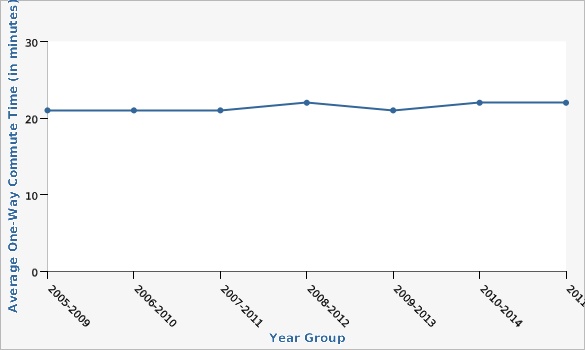
| Year Group | Average One-Way Commute Time (in minutes) | |||||
|---|---|---|---|---|---|---|
Record Count: 7 | ||||||
| 2005-2009 | 21 | |||||
| 2006-2010 | 21 | |||||
| 2007-2011 | 21 | |||||
| 2008-2012 | 22 | |||||
| 2009-2013 | 21 | |||||
| 2010-2014 | 22 | |||||
| 2011-2015 | 22 | |||||
Data Notes
Data are extracted from the National Environmental Public Health Tracking Network using their API. Average one-way commute measures use the mean commute time data from American Community Survey (ACS) Table S0801 five-year estimates to display the mean commute time for all travel modes combined at various geographic levels. [[br]] [[br]] Remaining measures use the ACS-defined commute time categories from Table B08314 that correspond to the national mean or median one-way commute time for a given transportation type. These categories are used to generate the number and percent of workers aged 16 and older in a given geographic area who have one-way commutes longer than a specified amount of time for a given mode of transportation.Data Source
American Community SurveyCommute Time: Average One-Way (minutes for workers 16 years and older for all travel modes) by County, Utah, 2011-2015
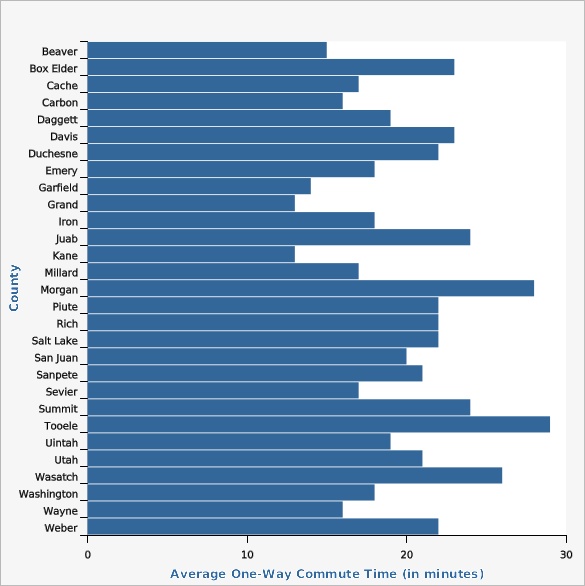
| County | Average One-Way Commute Time (in minutes) | |||||
|---|---|---|---|---|---|---|
Record Count: 29 | ||||||
| Beaver | 15 | |||||
| Box Elder | 23 | |||||
| Cache | 17 | |||||
| Carbon | 16 | |||||
| Daggett | 19 | |||||
| Davis | 23 | |||||
| Duchesne | 22 | |||||
| Emery | 18 | |||||
| Garfield | 14 | |||||
| Grand | 13 | |||||
| Iron | 18 | |||||
| Juab | 24 | |||||
| Kane | 13 | |||||
| Millard | 17 | |||||
| Morgan | 28 | |||||
| Piute | 22 | |||||
| Rich | 22 | |||||
| Salt Lake | 22 | |||||
| San Juan | 20 | |||||
| Sanpete | 21 | |||||
| Sevier | 17 | |||||
| Summit | 24 | |||||
| Tooele | 29 | |||||
| Uintah | 19 | |||||
| Utah | 21 | |||||
| Wasatch | 26 | |||||
| Washington | 18 | |||||
| Wayne | 16 | |||||
| Weber | 22 | |||||
Data Notes
Data are extracted from the National Environmental Public Health Tracking Network using their API. Average one-way commute measures use the mean commute time data from American Community Survey (ACS) Table S0801 five-year estimates to display the mean commute time for all travel modes combined at various geographic levels. [[br]] [[br]] Remaining measures use the ACS-defined commute time categories from Table B08314 that correspond to the national mean or median one-way commute time for a given transportation type. These categories are used to generate the number and percent of workers aged 16 and older in a given geographic area who have one-way commutes longer than a specified amount of time for a given mode of transportation.Data Source
American Community SurveyCommute Time: Number of Workers 16 Years and Older Driving 20+ Minutes to Work by Year, Utah, 2007-2015
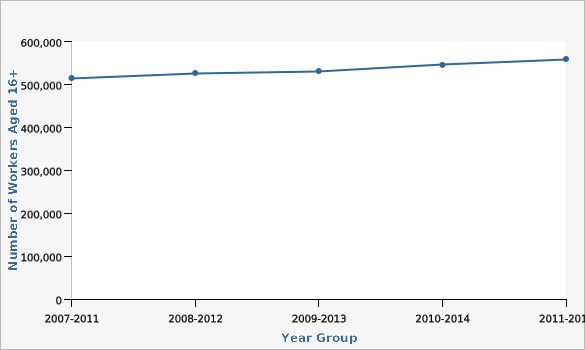
| Year Group | Number of Workers Aged 16+ | |||||
|---|---|---|---|---|---|---|
Record Count: 5 | ||||||
| 2007-2011 | 514,922 | |||||
| 2008-2012 | 526,551 | |||||
| 2009-2013 | 531,209 | |||||
| 2010-2014 | 545,458 | |||||
| 2011-2015 | 559,202 | |||||
Data Notes
Data are extracted from the National Environmental Public Health Tracking Network using their API. Average one-way commute measures use the mean commute time data from American Community Survey (ACS) Table S0801 five-year estimates to display the mean commute time for all travel modes combined at various geographic levels. [[br]] [[br]] Remaining measures use the ACS-defined commute time categories from Table B08314 that correspond to the national mean or median one-way commute time for a given transportation type. These categories are used to generate the number and percent of workers aged 16 and older in a given geographic area who have one-way commutes longer than a specified amount of time for a given mode of transportation.Data Source
American Community SurveyCommute Time: Number of Workers 16 Years and Older Driving 20+ Minutes to Work by County, Utah, 2011-2015
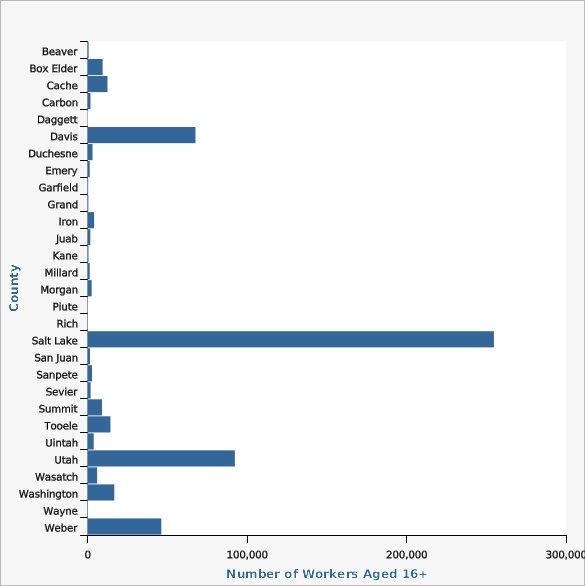
| County | Number of Workers Aged 16+ | |||||
|---|---|---|---|---|---|---|
Record Count: 29 | ||||||
| Beaver | 716 | |||||
| Box Elder | 9,471 | |||||
| Cache | 12,522 | |||||
| Carbon | 1,862 | |||||
| Daggett | 66 | |||||
| Davis | 67,696 | |||||
| Duchesne | 3,133 | |||||
| Emery | 1,399 | |||||
| Garfield | 420 | |||||
| Grand | 540 | |||||
| Iron | 4,159 | |||||
| Juab | 1,765 | |||||
| Kane | 597 | |||||
| Millard | 1,408 | |||||
| Morgan | 2,604 | |||||
| Piute | 224 | |||||
| Rich | 283 | |||||
| Salt Lake | 254,817 | |||||
| San Juan | 1,573 | |||||
| Sanpete | 2,829 | |||||
| Sevier | 1,935 | |||||
| Summit | 9,067 | |||||
| Tooele | 14,380 | |||||
| Uintah | 3,897 | |||||
| Utah | 92,401 | |||||
| Wasatch | 6,044 | |||||
| Washington | 16,794 | |||||
| Wayne | 326 | |||||
| Weber | 46,274 | |||||
Data Notes
Data are extracted from the National Environmental Public Health Tracking Network using their API. Average one-way commute measures use the mean commute time data from American Community Survey (ACS) Table S0801 five-year estimates to display the mean commute time for all travel modes combined at various geographic levels. [[br]] [[br]] Remaining measures use the ACS-defined commute time categories from Table B08314 that correspond to the national mean or median one-way commute time for a given transportation type. These categories are used to generate the number and percent of workers aged 16 and older in a given geographic area who have one-way commutes longer than a specified amount of time for a given mode of transportation.Data Source
American Community SurveyCommute Time: Number of Workers 16 Years and Older Taking Public Transportation 45+ Minutes to Work by Year, Utah, 2007-2015
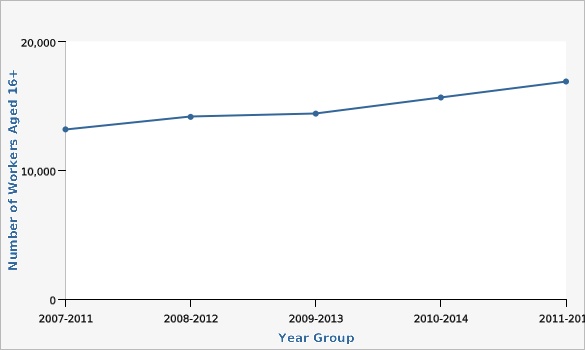
| Year Group | Number of Workers Aged 16+ | |||||
|---|---|---|---|---|---|---|
Record Count: 5 | ||||||
| 2007-2011 | 13,174 | |||||
| 2008-2012 | 14,143 | |||||
| 2009-2013 | 14,401 | |||||
| 2010-2014 | 15,655 | |||||
| 2011-2015 | 16,889 | |||||
Data Notes
Data are extracted from the National Environmental Public Health Tracking Network using their API. Average one-way commute measures use the mean commute time data from American Community Survey (ACS) Table S0801 five-year estimates to display the mean commute time for all travel modes combined at various geographic levels. [[br]] [[br]] Remaining measures use the ACS-defined commute time categories from Table B08314 that correspond to the national mean or median one-way commute time for a given transportation type. These categories are used to generate the number and percent of workers aged 16 and older in a given geographic area who have one-way commutes longer than a specified amount of time for a given mode of transportation.Data Source
American Community SurveyCommute Time: Number of Workers 16 Years and Older Taking Public Transportation 45+ Minutes to Work by County, Utah, 2011-2015
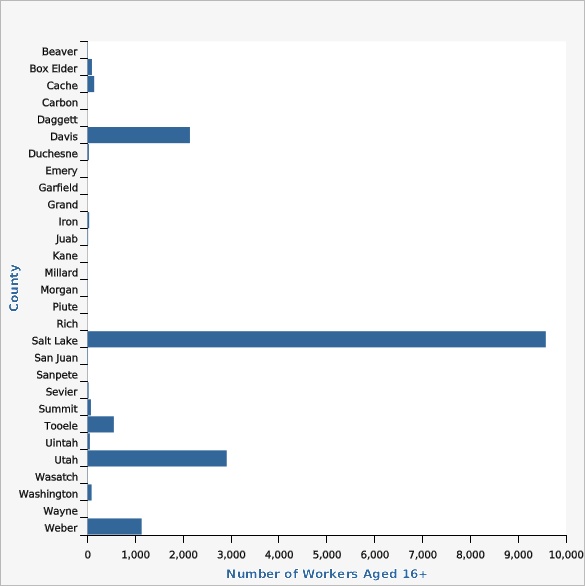
| County | Number of Workers Aged 16+ | |||||
|---|---|---|---|---|---|---|
Record Count: 29 | ||||||
| Beaver | 8 | |||||
| Box Elder | 93 | |||||
| Cache | 140 | |||||
| Carbon | 0 | |||||
| Daggett | 0 | |||||
| Davis | 2,141 | |||||
| Duchesne | 29 | |||||
| Emery | 0 | |||||
| Garfield | 0 | |||||
| Grand | 0 | |||||
| Iron | 35 | |||||
| Juab | 13 | |||||
| Kane | 0 | |||||
| Millard | 3 | |||||
| Morgan | 5 | |||||
| Piute | 0 | |||||
| Rich | 0 | |||||
| Salt Lake | 9,578 | |||||
| San Juan | 11 | |||||
| Sanpete | 2 | |||||
| Sevier | 24 | |||||
| Summit | 72 | |||||
| Tooele | 551 | |||||
| Uintah | 50 | |||||
| Utah | 2,910 | |||||
| Wasatch | 6 | |||||
| Washington | 86 | |||||
| Wayne | 0 | |||||
| Weber | 1,132 | |||||
Data Notes
Data are extracted from the National Environmental Public Health Tracking Network using their API. Average one-way commute measures use the mean commute time data from American Community Survey (ACS) Table S0801 five-year estimates to display the mean commute time for all travel modes combined at various geographic levels. [[br]] [[br]] Remaining measures use the ACS-defined commute time categories from Table B08314 that correspond to the national mean or median one-way commute time for a given transportation type. These categories are used to generate the number and percent of workers aged 16 and older in a given geographic area who have one-way commutes longer than a specified amount of time for a given mode of transportation.Data Source
American Community SurveyCommute Time: Number of Workers 16 Years and Older Walking 10+ Minutes to Work by Year, Utah, 2007-2015
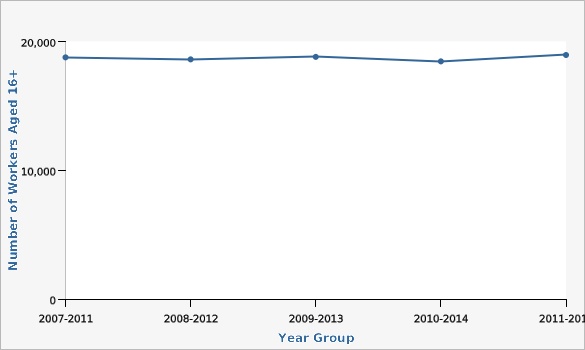
| Year Group | Number of Workers Aged 16+ | |||||
|---|---|---|---|---|---|---|
Record Count: 5 | ||||||
| 2007-2011 | 18,771 | |||||
| 2008-2012 | 18,614 | |||||
| 2009-2013 | 18,805 | |||||
| 2010-2014 | 18,457 | |||||
| 2011-2015 | 18,954 | |||||
Data Notes
Data are extracted from the National Environmental Public Health Tracking Network using their API. Average one-way commute measures use the mean commute time data from American Community Survey (ACS) Table S0801 five-year estimates to display the mean commute time for all travel modes combined at various geographic levels. [[br]] [[br]] Remaining measures use the ACS-defined commute time categories from Table B08314 that correspond to the national mean or median one-way commute time for a given transportation type. These categories are used to generate the number and percent of workers aged 16 and older in a given geographic area who have one-way commutes longer than a specified amount of time for a given mode of transportation.Data Source
American Community SurveyCommute Time: Number of Workers 16 Years and Older Walking 10+ Minutes to Work by County, Utah, 2011-2015

| County | Number of Workers Aged 16+ | |||||
|---|---|---|---|---|---|---|
Record Count: 29 | ||||||
| Beaver | 12 | |||||
| Box Elder | 142 | |||||
| Cache | 1,306 | |||||
| Carbon | 73 | |||||
| Daggett | 0 | |||||
| Davis | 1,317 | |||||
| Duchesne | 32 | |||||
| Emery | 39 | |||||
| Garfield | 0 | |||||
| Grand | 150 | |||||
| Iron | 343 | |||||
| Juab | 24 | |||||
| Kane | 49 | |||||
| Millard | 19 | |||||
| Morgan | 7 | |||||
| Piute | 2 | |||||
| Rich | 0 | |||||
| Salt Lake | 6,600 | |||||
| San Juan | 133 | |||||
| Sanpete | 145 | |||||
| Sevier | 64 | |||||
| Summit | 100 | |||||
| Tooele | 208 | |||||
| Uintah | 110 | |||||
| Utah | 6,750 | |||||
| Wasatch | 39 | |||||
| Washington | 474 | |||||
| Wayne | 5 | |||||
| Weber | 811 | |||||
Data Notes
Data are extracted from the National Environmental Public Health Tracking Network using their API. Average one-way commute measures use the mean commute time data from American Community Survey (ACS) Table S0801 five-year estimates to display the mean commute time for all travel modes combined at various geographic levels. [[br]] [[br]] Remaining measures use the ACS-defined commute time categories from Table B08314 that correspond to the national mean or median one-way commute time for a given transportation type. These categories are used to generate the number and percent of workers aged 16 and older in a given geographic area who have one-way commutes longer than a specified amount of time for a given mode of transportation.Data Source
American Community SurveyCommute Time: Percentage of Workers 16 Years and Older Driving 20+ Minutes to Work by Year, Utah, 2007-2015
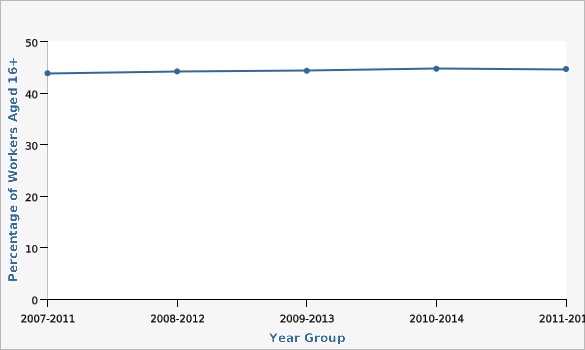
| Year Group | Percentage of Workers Aged 16+ | |||||
|---|---|---|---|---|---|---|
Record Count: 5 | ||||||
| 2007-2011 | 43.8% | |||||
| 2008-2012 | 44.2% | |||||
| 2009-2013 | 44.3% | |||||
| 2010-2014 | 44.7% | |||||
| 2011-2015 | 44.7% | |||||
Data Notes
Data are extracted from the National Environmental Public Health Tracking Network using their API. Average one-way commute measures use the mean commute time data from American Community Survey (ACS) Table S0801 five-year estimates to display the mean commute time for all travel modes combined at various geographic levels. [[br]] [[br]] Remaining measures use the ACS-defined commute time categories from Table B08314 that correspond to the national mean or median one-way commute time for a given transportation type. These categories are used to generate the number and percent of workers aged 16 and older in a given geographic area who have one-way commutes longer than a specified amount of time for a given mode of transportation.Data Source
American Community SurveyCommute Time: Percentage of Workers 16 Years and Older Driving 20+ Minutes to Work by County, Utah, 2011-2015
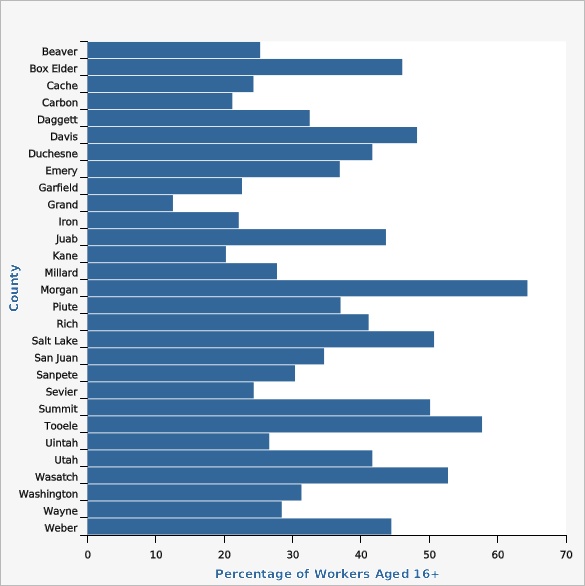
| County | Percentage of Workers Aged 16+ | |||||
|---|---|---|---|---|---|---|
Record Count: 29 | ||||||
| Beaver | 25.3% | |||||
| Box Elder | 46.0% | |||||
| Cache | 24.3% | |||||
| Carbon | 21.2% | |||||
| Daggett | 32.5% | |||||
| Davis | 48.2% | |||||
| Duchesne | 41.7% | |||||
| Emery | 36.9% | |||||
| Garfield | 22.6% | |||||
| Grand | 12.5% | |||||
| Iron | 22.1% | |||||
| Juab | 43.7% | |||||
| Kane | 20.2% | |||||
| Millard | 27.7% | |||||
| Morgan | 64.4% | |||||
| Piute | 37.0% | |||||
| Rich | 41.1% | |||||
| Salt Lake | 50.7% | |||||
| San Juan | 34.6% | |||||
| Sanpete | 30.4% | |||||
| Sevier | 24.3% | |||||
| Summit | 50.1% | |||||
| Tooele | 57.7% | |||||
| Uintah | 26.6% | |||||
| Utah | 41.7% | |||||
| Wasatch | 52.7% | |||||
| Washington | 31.3% | |||||
| Wayne | 28.4% | |||||
| Weber | 44.4% | |||||
Data Notes
Data are extracted from the National Environmental Public Health Tracking Network using their API. Average one-way commute measures use the mean commute time data from American Community Survey (ACS) Table S0801 five-year estimates to display the mean commute time for all travel modes combined at various geographic levels. [[br]] [[br]] Remaining measures use the ACS-defined commute time categories from Table B08314 that correspond to the national mean or median one-way commute time for a given transportation type. These categories are used to generate the number and percent of workers aged 16 and older in a given geographic area who have one-way commutes longer than a specified amount of time for a given mode of transportation.Data Source
American Community SurveyCommute Time: Percentage of Workers 16 Years and Older Taking Public Transportation 45+ Minutes to Work by Year, Utah, 2007-2015
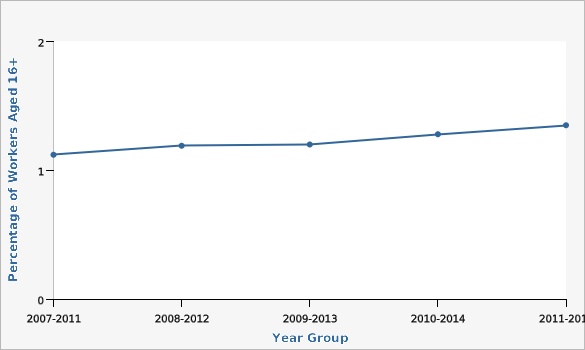
| Year Group | Percentage of Workers Aged 16+ | |||||
|---|---|---|---|---|---|---|
Record Count: 5 | ||||||
| 2007-2011 | 1.1% | |||||
| 2008-2012 | 1.2% | |||||
| 2009-2013 | 1.2% | |||||
| 2010-2014 | 1.3% | |||||
| 2011-2015 | 1.4% | |||||
Data Notes
Data are extracted from the National Environmental Public Health Tracking Network using their API. Average one-way commute measures use the mean commute time data from American Community Survey (ACS) Table S0801 five-year estimates to display the mean commute time for all travel modes combined at various geographic levels. [[br]] [[br]] Remaining measures use the ACS-defined commute time categories from Table B08314 that correspond to the national mean or median one-way commute time for a given transportation type. These categories are used to generate the number and percent of workers aged 16 and older in a given geographic area who have one-way commutes longer than a specified amount of time for a given mode of transportation.Data Source
American Community SurveyCommute Time: Percentage of Workers 16 Years and Older Taking Public Transportation 45+ Minutes to Work by County, Utah, 2011-2015
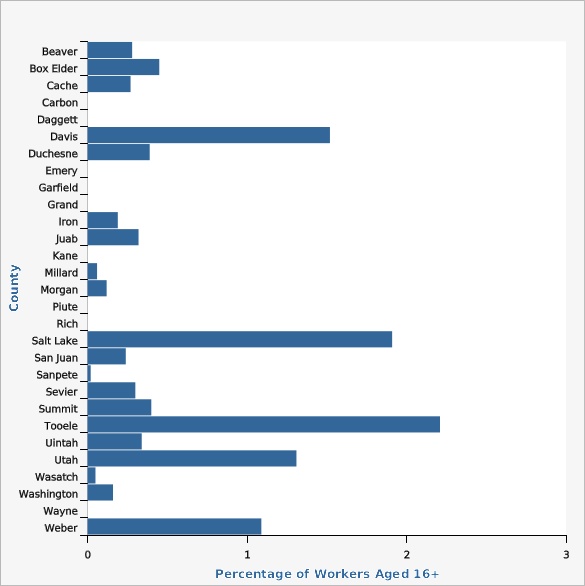
| County | Percentage of Workers Aged 16+ | |||||
|---|---|---|---|---|---|---|
Record Count: 29 | ||||||
| Beaver | 0.3% | |||||
| Box Elder | 0.4% | |||||
| Cache | 0.3% | |||||
| Carbon | 0.0% | |||||
| Daggett | 0.0% | |||||
| Davis | 1.5% | |||||
| Duchesne | 0.4% | |||||
| Emery | 0.0% | |||||
| Garfield | 0.0% | |||||
| Grand | 0.0% | |||||
| Iron | 0.2% | |||||
| Juab | 0.3% | |||||
| Kane | 0.0% | |||||
| Millard | 0.1% | |||||
| Morgan | 0.1% | |||||
| Piute | 0.0% | |||||
| Rich | 0.0% | |||||
| Salt Lake | 1.9% | |||||
| San Juan | 0.2% | |||||
| Sanpete | 0.0% | |||||
| Sevier | 0.3% | |||||
| Summit | 0.4% | |||||
| Tooele | 2.2% | |||||
| Uintah | 0.3% | |||||
| Utah | 1.3% | |||||
| Wasatch | 0.0% | |||||
| Washington | 0.2% | |||||
| Wayne | 0.0% | |||||
| Weber | 1.1% | |||||
Data Notes
Data are extracted from the National Environmental Public Health Tracking Network using their API. Average one-way commute measures use the mean commute time data from American Community Survey (ACS) Table S0801 five-year estimates to display the mean commute time for all travel modes combined at various geographic levels. [[br]] [[br]] Remaining measures use the ACS-defined commute time categories from Table B08314 that correspond to the national mean or median one-way commute time for a given transportation type. These categories are used to generate the number and percent of workers aged 16 and older in a given geographic area who have one-way commutes longer than a specified amount of time for a given mode of transportation.Data Source
American Community SurveyCommute Time: Percentage of Workers 16 Years and Older Walking 10+ Minutes to Work by Year, Utah, 2007-2015
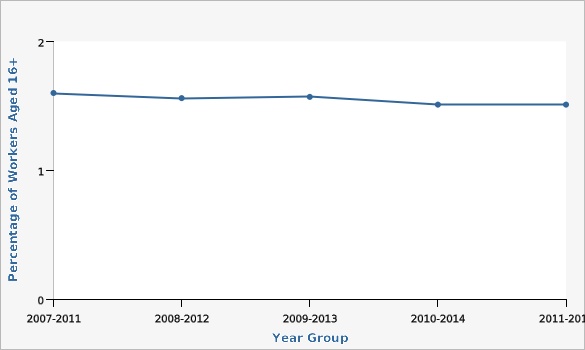
| Year Group | Percentage of Workers Aged 16+ | |||||
|---|---|---|---|---|---|---|
Record Count: 5 | ||||||
| 2007-2011 | 1.6% | |||||
| 2008-2012 | 1.6% | |||||
| 2009-2013 | 1.6% | |||||
| 2010-2014 | 1.5% | |||||
| 2011-2015 | 1.5% | |||||
Data Notes
Data are extracted from the National Environmental Public Health Tracking Network using their API. Average one-way commute measures use the mean commute time data from American Community Survey (ACS) Table S0801 five-year estimates to display the mean commute time for all travel modes combined at various geographic levels. [[br]] [[br]] Remaining measures use the ACS-defined commute time categories from Table B08314 that correspond to the national mean or median one-way commute time for a given transportation type. These categories are used to generate the number and percent of workers aged 16 and older in a given geographic area who have one-way commutes longer than a specified amount of time for a given mode of transportation.Data Source
American Community SurveyCommute Time: Percentage of Workers 16 Years and Older Walking 10+ Minutes to Work by County, Utah, 2011-2015
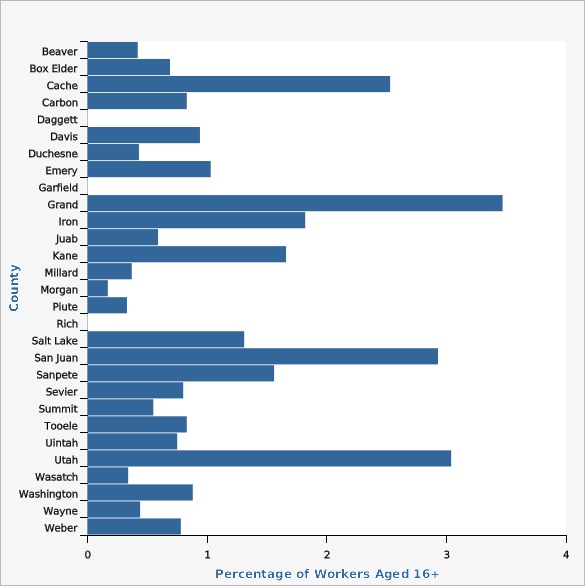
| County | Percentage of Workers Aged 16+ | |||||
|---|---|---|---|---|---|---|
Record Count: 29 | ||||||
| Beaver | 0.4% | |||||
| Box Elder | 0.7% | |||||
| Cache | 2.5% | |||||
| Carbon | 0.8% | |||||
| Daggett | 0.0% | |||||
| Davis | 0.9% | |||||
| Duchesne | 0.4% | |||||
| Emery | 1.0% | |||||
| Garfield | 0.0% | |||||
| Grand | 3.5% | |||||
| Iron | 1.8% | |||||
| Juab | 0.6% | |||||
| Kane | 1.7% | |||||
| Millard | 0.4% | |||||
| Morgan | 0.2% | |||||
| Piute | 0.3% | |||||
| Rich | 0.0% | |||||
| Salt Lake | 1.3% | |||||
| San Juan | 2.9% | |||||
| Sanpete | 1.6% | |||||
| Sevier | 0.8% | |||||
| Summit | 0.6% | |||||
| Tooele | 0.8% | |||||
| Uintah | 0.8% | |||||
| Utah | 3.0% | |||||
| Wasatch | 0.3% | |||||
| Washington | 0.9% | |||||
| Wayne | 0.4% | |||||
| Weber | 0.8% | |||||
Data Notes
Data are extracted from the National Environmental Public Health Tracking Network using their API. Average one-way commute measures use the mean commute time data from American Community Survey (ACS) Table S0801 five-year estimates to display the mean commute time for all travel modes combined at various geographic levels. [[br]] [[br]] Remaining measures use the ACS-defined commute time categories from Table B08314 that correspond to the national mean or median one-way commute time for a given transportation type. These categories are used to generate the number and percent of workers aged 16 and older in a given geographic area who have one-way commutes longer than a specified amount of time for a given mode of transportation.Data Source
American Community SurveyMore Resources and Links
Evidence-based community health improvement ideas and interventions may be found at the following sites:Additional indicator data by state and county may be found on these Websites:
- CDC Prevention Status Reports for all 50 states
- County Health Rankings
- Kaiser Family Foundation's StateHealthFacts.org
- CDC WONDER DATA2010, the Healthy People 2010 Database.
Medical literature can be queried at the PubMed website.
Page Content Updated On 07/10/2018,
Published on 08/10/2018





